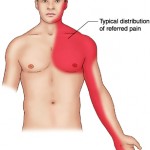ANGINA PECTORIS
 Angina pectoris, the primary symptom of ischemic heart disease, is caused by transient episodes of myocardial ischemia that are due to an imbalance in the myocardial oxygen supply-demand relationship. This imbalance may be caused by an increase in myocardial oxygen demand (which is determined by heart rate, ventricular contractility, and ventricular wall tension) or by a decrease in myocardial oxygen supply (primarily determined by coronary blood flow but occasionally modified by the oxygen-carrying capacity of the blood) or sometimes by both. Since blood flow is inversely proportional to the fourth power of the artery’s luminal radius, the progressive decrease in vessel radius that characterizes coronary atherosclerosis can impair coronary blood flow and lead to symptoms of angina when myocardial oxygen demand increases, as with exertion (so-called typical angina pectoris).
Angina pectoris, the primary symptom of ischemic heart disease, is caused by transient episodes of myocardial ischemia that are due to an imbalance in the myocardial oxygen supply-demand relationship. This imbalance may be caused by an increase in myocardial oxygen demand (which is determined by heart rate, ventricular contractility, and ventricular wall tension) or by a decrease in myocardial oxygen supply (primarily determined by coronary blood flow but occasionally modified by the oxygen-carrying capacity of the blood) or sometimes by both. Since blood flow is inversely proportional to the fourth power of the artery’s luminal radius, the progressive decrease in vessel radius that characterizes coronary atherosclerosis can impair coronary blood flow and lead to symptoms of angina when myocardial oxygen demand increases, as with exertion (so-called typical angina pectoris).
In some patients, anginal symptoms may occur without any increase in myocardial oxygen demand but rather as a consequence of abrupt reduction in blood flow, as might result from coronary thrombosis (unstable angina) or vasospasm (variant or Prinzmetal angina). Regardless of the precipitating factors, the sensation of angina is similar in most patients. Typical angina is experienced as a heavy, pressing sub sternal discomfort (rarely called “pain”), often radiating to the left shoulder, flexor aspect of the left arm, jaw, or epigastrium. However, a significant minority of patients notes discomfort in a different location or of a different character. Women, the elderly, and diabetics are more likely to have ischemia with atypical symptoms. In most patients with typical angina, whose symptoms are provoked by exertion, the symptoms are relieved by rest or by administration of sublingual nitro-glycerine.
Angina pectoris is a common symptom, affecting more than 6 million Americans. Angina pectoris may occur in a stable pattern over many years or may become unstable, increasing in frequency or severity and even occurring at rest. In typical stable angina, the pathological substrate is usually fixed atherosclerotic narrowing of an epicardial coronary artery, on which exertion or emotional stress superimposes an increase in myocardial oxygen consumption. In variant angina, focal or diffuse coronary vasospasm episodically reduces coronary flow. Patients also may display a mixed pattern of angina with the addition of altered vessel tone on a background of atherosclerotic narrowing. In most patients with unstable angina, rupture of an atherosclerotic plaque, with consequent platelet adhesion and aggregation, decreases coronary blood flow. Plaques with thinner fibrous caps are more “vulnerable” to rupture.
Myocardial ischemia also may be silent, with electrocardiographic, echocardiographic, or radionuclide evidence of ischemia appearing in the absence of symptoms. While some patients have only silent ischemia, most patients who have silent ischemia have symptomatic episodes as well. The precipitants of silent ischemia appear to be the same as those of symptomatic ischemia. We now know that the ischemic burden, i.e., the total time a patient is ischemic each day, is greater in many patients than was recognized previously. In most trials, the agents that are efficacious in conventional angina are also efficacious in reducing silent ischemia. b Adrenergic receptor antagonists appear to be more effective than the Ca2+ channel blockers in the prevention of episodes.
Therapy directed at abolishing all silent ischemia has not been shown to be of additional benefit over conventional therapy.
The major drugs are nitro vasodilators, b adrenergic receptor antagonists, Ca2+ channel antagonists, and in stable and unstable angina, antiplatelet agents as well as statins (HMG CoA-reductase inhibitors), which may have a role in stabilizing the vulnerable plaque. All approved antianginal agents improve the balance of myocardial oxygen supply and demand, increasing supply by dilating the coronary vasculature or decreasing demand by reducing cardiac work. Increasing the cardiac extraction of oxygen from the blood is not a practical therapeutic goal.
Drugs used in typical angina function principally by reducing myocardial oxygen demand by decreasing heart rate, myocardial contractility, and/or ventricular wall stress. Patients with mild or moderate stable angina, who do not have left ventricular dysfunction, may be managed effectively with sublingual glyceryl trinitrate and regular administration of a beta-blocker. If necessary a long-acting dihydropyridine calcium-channel blocker and then a long-acting nitrate may be added. For those without left ventricular dysfunction and in whom beta-blockers are inappropriate, diltiazem or verapamil may be given and a long-acting nitrate may be added if symptom control is not adequate. For those intolerant of standard treatment, or where standard treatment has failed, nicorandil may be tried.
For angina in patients with left ventricular dysfunction a long-acting nitrate or a long-acting dihydropyridine calcium-channel blocker, such as amlodipine or felodipine should be used alone, or in combination, to prevent clinical deterioration; nicorandil can also be considered as an alternative treatment. Increasingly, a beta-blocker is also used in clinically stable patients; treatment should be started at a very low dose and titrated very slowly over a period of weeks or months.
By contrast, the principal therapeutic goal in unstable angina is to increase myocardial blood flow; strategies include the use of antiplatelet agents and heparin to reduce intracoronary thrombosis and coronary stents or coronary bypass surgery to restore flow by mechanical means. The therapeutic aim in variant or Prinzmetal angina is to prevent coronary vasoplasm.
Antianginal agents may provide prophylactic or symptomatic treatment, but b adrenergic receptor antagonists also reduce mortality apparently by decreasing the incidence of sudden cardiac death associated with myocardial ischemia and infarction. The treatment of cardiac risk factors can reduce the progression or even lead to the regression of atherosclerosis. Aspirin is used routinely in patients with myocardial ischemia, and daily aspirin use reduces the incidence of clinical events. Other antiplatelet agents such as oral clopidogrel and intravenous anti-integrin drugs such as abciximab, tirofiban, and eptifibatide have been shown to reduce morbidity in patients with angina who undergo coronary artery stenting.
Lipid-lowering drugs such as the statins reduce mortality in patients with hypercholesterolemia with or without known coronary artery disease. Angiotensin-converting enzyme (ACE) inhibitors also reduce mortality in patients with coronary disease. Coronary artery bypass surgery and percutaneous coronary interventions such as angioplasty and coronary artery stent deployment can complement pharmacological treatment. In some subsets of patients, percutaneous or surgical revascularization may have a survival advantage over medical treatment alone. Intracoronary drug delivery using drug-eluting coronary stents represents an intersection of mechanical and pharmacological approaches in the treatment of coronary artery disease. Novel therapies that modify the expression of vascular or myocardial cell genes eventually may become an important part of the therapy of ischemic heart disease.
By: Ammarah Khan




Heya i’m for the first time here. I found this board and I to find It truly helpful & it helped me out much. I hope to provide one thing back and help others like you aided me.
There are certainly a lot of details like that to take into consideration. That is a great point to bring up. I offer the thoughts above as general inspiration but clearly there are questions like the one you bring up where the most important thing will be working in honest good faith. I don?t know if best practices have emerged around things like that, but I am sure that your job is clearly identified as a fair game. Both boys and girls feel the impact of just a moment’s pleasure, for the rest of their lives.
I’m not that much of a internet reader to be honest but your sites really nice, keep it up! I’ll go ahead and bookmark your website to come back later on. All the best
sure. Pls keep on leaving your worth opinion in future.
Thank you
Thanks
We are happy to know that. Pls keep on providing your feed back.
Happy reading.
Identified your write-up extremely exciting certainly. I genuinely enjoyed reading it and you simply make very some very good factors. I will bookmark this web page to the long run! Relly terrific report.
Uncovered your article very exciting indeed. I truly appreciated reading it therefore you make rather some very good points. I’ll bookmark this web-site to the potential! Relly terrific write-up.
There are certainly a lot of details like that to take into consideration. That is a great point to bring up. I offer the thoughts above as general inspiration but clearly there are questions like the one you bring up where the most important thing will be working in honest good faith. I don?t know if best practices have emerged around things like that, but I am sure that your job is clearly identified as a fair game. Both boys and girls feel the impact of just a moment’s pleasure, for the rest of their lives.
Hey just wanted to give you a quick heads up. The text in your article seem to be running off the screen in Opera. I’m not sure if this is a format issue or something to do with internet browser compatibility but I thought I’d post to let you know. The design and style look great though! Hope you get the problem solved soon. Many thanks
Youre so cool! I dont suppose Ive learn something like this before. So nice to seek out someone with some original ideas on this subject. realy thank you for beginning this up. this web site is something that is wanted on the web, someone with somewhat originality. helpful job for bringing something new to the web!
Aw, this was a really nice post. In idea I would like to put in writing like this additionally – taking time and actual effort to make a very good article… but what can I say… I procrastinate alot and by no means seem to get something done.
I constantly spent my half an hour to read this webpage’s articles all the time along with a mug of coffee.
Good day, got excited to find the webpage. Really only found it with aol however was not looking for anything at all related in particular to that actually, though I liked reading through up on your stuff you had to state. Thanks !!
I just want to mention I am just newbie to blogging and seriously savored your blog. Most likely I’m planning to bookmark your website . You surely come with incredible well written articles. Thanks for sharing your website page.
Your blog has the same post as another author but i like your better.”~;”:
your blog design is wonderfull, it makes me want to hang around longer, you obviously know what you are doing, cheers